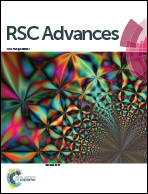On preparing highly abrasion resistant binderless and in situ N-doped granular activated carbon†
Abstract
NaOH/urea, a cellulose solvent, has been applied for the preparation of binderless and in situ N-doped GACs (NaOH/urea-GACs). The dissolved cellulose binds lignin, hemicellulose and undissolved cellulose all together to form a granular precursor after kneading and extruding. During the process, NaOH and urea are dispersed in sawdust where the NaOH acts as an activator at high temperatures, and the urea plays the role of an in situ N-dopant. The results show that at a mass concentration ratio of 14 wt% NaOH/24 wt% urea which has been activated for 1 h at 850 °C after kneading for 2 h GACs with a specific surface area (SBET) of 811.299 m2 g−1, a microporosity of 59.20% and an abrasion resistance of 99.83% are obtained. The N content as well as its form of existence are also further explored. The desulfurization ability of the NaOH/urea-GACs is also investigated, and NaOH/urea-GACs, without removed alkali, are applied for desulfurization, and the adsorption process is appropriate for the Bangham model. The experimental results indicate that it is feasible to use an NaOH/urea solvent as a suitable chemical for the manufacture of GACs with good properties.



 Please wait while we load your content...
Please wait while we load your content...